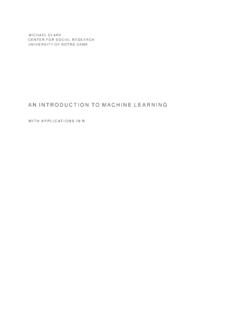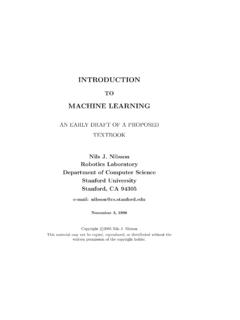Transcription of Introduction to Machine Learning in Healthcare
1 Introduction toMachine Learningin HealthcareA Tsunami of InformationIntroduction by Ian McCrae / Orion Health Founder and CEO15 minutes. That s how long your doctor has to see you, assess your complaint, diagnose a solution, and see you out the door hopefully on the path back to isn t much time when you consider the wealth of information that he or she has to consider: your patient record, the medical research relevant to your complaint, the answers about your condition that you provide, and the basic examination ( say aaaaaaah ) that is carried how will your doctor cope when faced with the tsunami of Healthcare information that will occur when it is routine for your patient record to include data about your genome, your microbiome (microorganisms in your body), and your fitness regime?Your electronic health record is fast becoming the most powerful tool in the medical toolkit.
2 All the information will be stored in the cloud. It will have to be, because the size of the electronic file containing your complete patient record is estimated to be as much as six terabytes. That s a quarter of the whole of Wikipedia!A data file that large is required to enable the practice of precision medicine. This is a new revolution in Healthcare . It is the ability to target Healthcare treatment specifically for an individual. In addition to improving health outcomes, precision medicine will save vital health dollars because it is enabled by unique data insights that lead to more targeted treatments. For example, when I had my genome mapped I found out that ibuprofen doesn t work for me. The only effect that drug has is on my wallet that is, what it costs me to buy the how will a doctor process all this new information in the short time in which they see their patient?
3 The truth is they can t. It will require high-powered computing that uses insights from Machine Learning a type of artificial intelligence that enables computers to find hidden insights without being programmed. Algorithms will scan vast data sets and identify recommended treatment plans tailored to are two things required for the successful application of Machine Learning in Healthcare intelligent algorithms and rich data sets. Orion Health is at the forefront of developing both areas. We have invested in the Precision Driven Health initiative, a world-leading, multi-million-dollar research program that is investigating how the application of Machine Learning will enable new Healthcare solutions that are more precisely tailored to a person s unique characteristics. And since our software manages over 100 million patient records globally, we believe we re one of the few health software companies in the world capable of carrying out Machine Learning have produced this brief Introduction to Machine Learning because this is an exciting time to be part of the global Healthcare sector.
4 As a discipline, health is transforming into a mathematical science, but at its heart, it will always be about enabling the perfect care for everyone, anywhere in the world. Factors Influencing HealthMcGinnis et. al. Human Affairs, Vol. 22 (2)42+32+10+16 Behavioral Choices 42%Genetics 32% Healthcare 10%Social Circumstances 16%Social DataPersonal circumstances, such as living situation and incomeExposomeImpact of the external environment, such as pollution and tobacco smoke, DataInformation collected from apps that measure fitness and sleeping, electronic inhalers, created from DNA to form the template (mRNA) of proteinsProteomeSystem of proteins, including enzymes, which are the building blocks of the body Epigenetic (Methylome)The set of nucleric and methylation modifications in a human genomeMetabolomeChemicals which are created, modified, and broken down by bodily processes, such as enzymatic reactionsMicrobiomeCollective name for 100 trillion microorganisms living inside usGenomePatient's complete set of genes written in DNAI magingMedical images, such as x-rays, scans, ultrasounds, DataPatient's medical recordUseful Data for the Practice of Precision MedicineA Short Introduction to Machine LearningBy Dr.
5 Kathryn Hempstalk / Senior Data Scientist, Precision Driven HealthSelf-driving cars, Siri, and websites that recommend items based on the purchasing decisions of other people: what do these have in common? They are all real-world examples of Machine Learning . Machine Learning is when a computer uses an algorithm to understand the data it has been given and recognizes patterns. We call the process of Learning training, and the output that this process produces is called a model. A model can be provided new data and reason against it based on what the model has previously Learning models determine a set of rules using vast amounts of computing power that a human brain would be incapable of processing. The more data a Machine Learning model is fed, the more complex the rules and the more accurate the a statistical model is likely to have an inherent logic that can be understood by most people, the rules created by Machine Learning are often beyond human comprehension because our brains are incapable of digesting and analyzing enormous data sets.
6 In the following section, we will look at three types of models used in Machine Learning classification, clustering, and regression and review the concept of deep purpose of the classification model is to determine a label or category it is either one thing or the other. We train the model using a set of labeled data. As an example, if we wanted to predict whether a person s mole is cancerous or not, we would create a model using a data set of mole scans from 1,000 patients that a doctor has already examined for cancer. We would also feed the model lots of other data, such as a patient s age, gender, ethnicity, and place of residence. We would then create a model which will enable us to decide whether it depicts graph (Fig. 1) is an example of a classification model. The dotted line is the rule determined by the model that best separates the positive and negative results, based on the data provided during we were using our mole scan example, then in this graph the circles are the mole scans that show that cancer is likely, and the squares are the mole scans that show that cancer is unlikely.
7 Each time we train the algorithm with additional data, it should improve the accuracy of the Model (Fig. 1)data showing positive resultdata showing negative resultDotted line is the rule determined by the algorithmClusteringWe would create a clustering model if we had a whole bunch of data, didn t have a determined outcome, and just wanted to see if there were any distinctive patterns. An example might be that of a primary care provider in an effort to see if there is a pattern to the type of complaints she has seen in the past year creating a model based on a year s worth of patient data. The model might show that people living in a certain area have higher rates of cancer, which would warrant further examination ( , is there an issue with the water supply? Is there pollution from a nearby factory?)
8 The graph (Fig. 2) shows the rules (dotted lines) determined by the algorithm using the data set. The patient files are clustered into various groups, but a human must label each Model (Fig. 2)Dotted lines are the rules determined by the algorithmRegressionA regression model is created when we want to find out a number ( , how many days before a patient discharged from the hospital with a chronic condition such as diabetes will return). We start with a data set that is already labeled with numbers ( , how many days before each patient returns to the hospital) and feed this and the patient s other data ( , age, gender, etc.) into the model. The model tries to learn a pattern that describes how long before a patient returns to the graph (Fig. 3) plots various patients against the number of days between hospitalizations, and the dotted line is the model that best predicts the outcome.
9 This regression model predicts the time before rehospitalization for a new Model (Fig. 3)Data set plotted to find out a number ( , how many days before a patient returns to the hospital)Deep Learning Deep Learning is an often-misused buzzphrase that refers to a special case of a Machine Learning algorithm: the artificial neural neural network is an algorithm inspired by the way a brain works. It involves many nodes (or neurons) that are often connected together in layers to form a network. A neural network must have at leasttwo layers a layer of inputs and a layer of may be many hidden layers between the input and output layers, and these are used to extract more information by exploiting structure in the data. A network is considered deep if it has more than one hidden layer (see the Deep Learning Neural Network diagram [opposite], which illustrates the complexity of a neural network).
10 Neural networks are great at solving problems where the data is highly structured like an image of a brain scan but they are black box algorithms. In other words, it is hard to describe to a human being the patterns found by neural networks. Despite being around for over 50 years, neural networks have only become popular and feasible in the last 10 years thanks to advances in both algorithm design and computing power. 1234 Pixels taken from an image and mapped as inputsPartially connectedFully connectedPredictionINPUTHIDDENOUTPUTL ayersIMAGE1234 Data is CriticalMany major advances in Machine Learning actually occur from data sets, not algorithms. When IBM s Deep Blue defeated chess grandmaster Garry Kasperov, the algorithm was 14 years old, but the data set was only six years old. Google learned to translate Chinese to English using a 17-year-old algorithm and data they collected in 2015.









